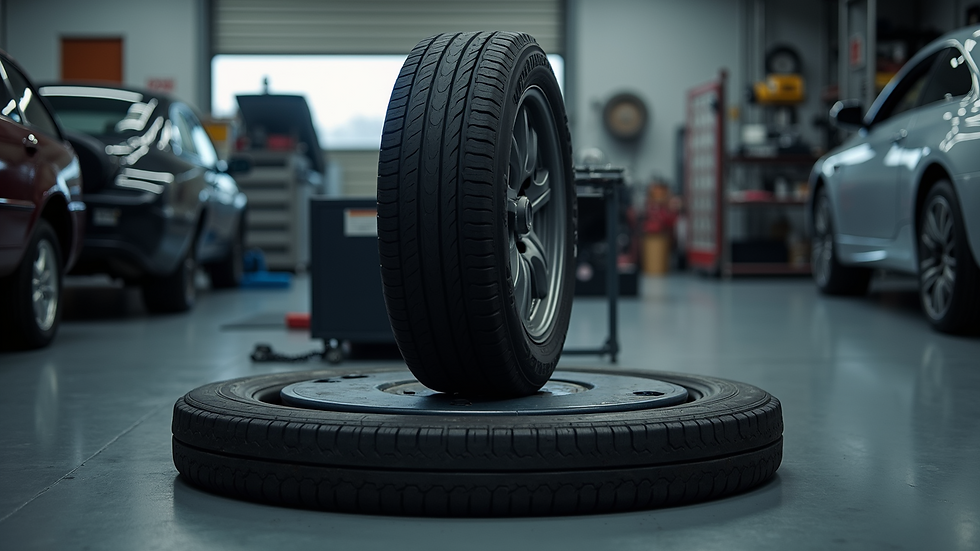Understanding Vehicle Vibrations: Causes and Solutions
- Kirill Anikin
- Jun 20
- 4 min read
Updated: Aug 20
Vibrations can originate from different parts of the vehicle, each impacting the driving experience differently. While some vibrations might be harmless, others may point to more serious issues that require immediate attention.
Common Sources of Vibrations

Tires: Tires are often the primary reason for vibrations when driving fast. According to experts, around 60% of vibration issues are linked to tire problems. If a tire is out of balance, misaligned, or experiencing uneven wear, it can lead to significant vibrations at highway speeds. For instance, a tire that is improperly inflated can wear unevenly, resulting in vibrations that might start around 50 mph.
Wheels: Much like tires, wheels can also cause vibrations. Issues such as bent rims, corrosion, or improper balancing can lead to instability. Research shows that about 30% of wheel-related vibrations stem from misalignment.
Axles and Driveshafts: Damaged or worn axles and driveshafts are another source of vibrations, particularly noticeable when accelerating. These components are critical for transferring power from the engine to the wheels.

Suspension and Steering Components: If your suspension system is compromised, you may feel vibrations while driving. Components like worn shock absorbers or bushings can significantly impact how your vehicle handles.
Engine and Transmission Mounts: These mounts are designed to absorb vibrations. If they are damaged or worn out, vibrations can be felt, especially during acceleration.
Brake Components: If you notice vibrations only when braking, this could be a sign of warped brake rotors, which can compromise safety and overall vehicle performance.
Diagnosing Your Vehicle’s Vibration Issue
After confirming that your vehicle is vibrating, it’s important to diagnose the issue properly.
Visual Inspection
Start with a thorough inspection of your tires and wheels. Look for uneven wear patterns or bulges. For example, a bulging tire can be a sign of damage that might affect your safety. Make sure all lug nuts are tightened. According to statistics, about 23% of tire-related issues are due to loose lug nuts.
Road Test
Take your vehicle for a test drive. Note when the vibrations occur—is it only at certain speeds or all the time? Check if the vibration is felt in the steering wheel, seat, or brake pedal. This information can help identify the source of the problem.
Listen for Sounds
Pay attention to any unusual noises accompanying the vibrations. For example, a grinding sound may hint at brake issues, while clunks could indicate suspension problems. Sounds can often provide clues to the diagnosis.
Addressing Vibrations: What You Can Do
Once you pinpoint the root cause, consider these steps to address the issue effectively.
Balance and Align Your Tires
If tire imbalance or misalignment is the problem, schedule an appointment for a professional tire balance and alignment. Regular alignments, suggested to be done every 5,000 to 10,000 miles, can help extend tire life and prevent future issues.

Inspect Wheels and Suspension
For wheel issues, consult a professional to inspect for damages or bends. A visual check can reveal problems that might not be immediately apparent. Have your suspension assessed, and replace any worn components as soon as possible to prevent further complications.
Check Driveshaft and Axles
If you suspect that driveshaft or axle issues are at play, seek help from a qualified mechanic. They can perform a thorough evaluation and determine whether these essential components are functioning properly or need replacement.
Monitor Engine and Transmission Mounts
Keep an eye on the condition of your engine and transmission mounts. If you notice signs of wear, replacing them is generally a simple process that can make a significant difference in the vibration levels inside your vehicle.
Preventive Measures: Keeping Vibrations at Bay
After addressing any existing issues, focusing on preventive measures is crucial to maintaining a smooth ride on the highway.
Regular Maintenance
Routine vehicle maintenance is essential for preventing major issues down the road. Schedule regular inspections that cover tire rotations, alignment checks, and system inspections. In fact, cars that are serviced regularly are 50% less likely to experience severe mechanical failures.
Monitor Tire Health
Regularly check your tire pressure and watch for signs of uneven wear. Maintaining proper tire pressure, ideally around 35 PSI for most vehicles, not only reduces the risk of imbalances but also enhances handling and fuel efficiency.
Drive Responsibly
Adopting responsible driving habits can improve your vehicle's performance. Avoid sudden accelerations and hard braking, which can increase wear and tear on critical components.
When to Seek Professional Help
While many issues can be managed with some DIY inspections, certain problems require expert assistance.
Signs You Need a Mechanic
If vibrations persist after your checks, it's time to consult a mechanic. Look for:
Excessive shaking: If the vibrations feel severe or get worse, this may indicate a serious issue.
Unusual noises: Continuous grinding, clunking, or rattling sounds could indicate underlying problems that need attention.
Changes in handling: If your steering becomes unresponsive or misaligned, don't hesitate to reach out to a professional.
Final Thoughts
Experiencing vibrations at highway speeds can be concerning, but understanding their potential causes helps you tackle the problem effectively. From tires and wheels to engine components, various factors can contribute to unwanted vibrations. Regular maintenance and attentiveness can prevent severe consequences and enhance your driving experience.
If issues persist, consult a professional mechanic for a comprehensive check-up. Keeping your vehicle well-maintained not only improves your enjoyment on the road but also ensures safety for you and your passengers.





Comments